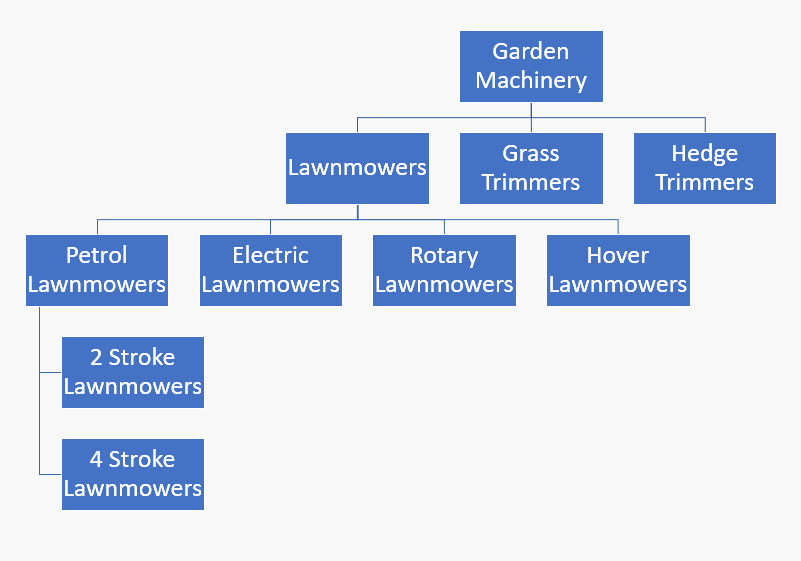Matching the site to the market. 3 important points:
- A fundamental principle of e-commerce search engine optimisation is targeted categorisation.
- This approach allows us to dedicate a page (a category in this instance) to a target keyword – technically optimise it for that keyword and include copy only related to that keyword.
- Targeting numerous keywords with one page dilutes the topical relevance (for search engines, pages discussing multiple topics can introduce uncertainty regarding the focus of the page)
Scarifiers & Cultivators
People tend to search with single product focus – they don’t use broad, traditional retail categories.
Search volume figures from Google confirm this:
| Search Term | Jan-16 | Feb-16 | Mar-16 | Apr-16 | May-16 | Jun-16 | Jul-16 | Aug-16 | Sep-16 | Oct-16 | Nov-16 | Dec-16 |
|---|---|---|---|---|---|---|---|---|---|---|---|---|
| scarifiers and cultivators | 0 | 0 | 0 | 0 | 0 | 0 | 0 | 0 | 0 | 0 | 0 | 0 |
| scarifiers | 1900 | 4400 | 18100 | 22200 | 18100 | 9900 | 6600 | 8100 | 8100 | 6600 | 2900 | 1900 |
| cultivators | 8100 | 9900 | 9900 | 12100 | 12100 | 9900 | 8100 | 8100 | 8100 | 9900 | 9900 | 8100 |
A category titled “scarifiers and cultivators” doesn’t directly match the intent of any searches.
Categories targeted to each individually, match the intent of c.18000 searches every month in the UK.
Therefore, once we understand the product range, and the way in which the market searches, we can categorise and subcategorise the e-commerce site into a series of logical hubs which comprise of a set of unique category pages which are optimised to meet specific search demand.
Intent, Relevancy & Conversion
Rather than one top level page for a product type, following this approach allows us to create categories targeting a wide variety of market segments, all of which are at different stages of the buying process.
The intent behind a search for “lawnmowers” is likely to be broad and informational, a search for petrol lawnmowers is more focused, with greater intent to purchase.
A search for “4 stroke petrol lawnmowers” is well qualified, and typically has a higher probability of conversion.
In Practise
Sub-categorisation of the lawnmowers category allows us to create multiple pages targeted to qualified search terms.
In addition, rather than the site having one page related to lawnmowers, we now have a 7 page hub – more related content, and ultimately more dedicated, detailed, expert content related to the topic – a major indicator to Google that the site is an authority on the subject in question.
We also improve conversion probability, as the searcher looking for 4 stroke lawnmowers via search is directed to the page that contains only the information and products they are interested in.

Visibility & Volume
Following this approach, we maximise potential visibility for the site.
Visibility amongst a higher number of searches ultimately translates into a higher number of visitors. Sub categorising allows visibility for well qualified, less broad search terms.
| Search Term | Jan-16 | Feb-16 | Mar-16 | Apr-16 | May-16 | Jun-16 | Jul-16 | Aug-16 | Sep-16 | Oct-16 | Nov-16 | Dec-16 |
|---|---|---|---|---|---|---|---|---|---|---|---|---|
| lawnmowers | 18100 | 33100 | 74000 | 90500 | 165000 | 110000 | 110000 | 74000 | 60500 | 40500 | 18100 | 14800 |
| petrol lawnmowers | 6600 | 12100 | 18100 | 18100 | 22200 | 18100 | 18100 | 12100 | 9900 | 6600 | 2900 | 1900 |
| electric lawnmowers | 1900 | 3600 | 8100 | 9900 | 14800 | 12100 | 12100 | 8100 | 6600 | 3600 | 1900 | 1300 |
| hover lawnmowers | 20 | 50 | 170 | 140 | 170 | 110 | 140 | 110 | 50 | 30 | 10 | 10 |
| 2 stroke lawnmowers | 10 | 20 | 50 | 140 | 110 | 110 | 90 | 90 | 50 | 30 | 20 | 20 |
| rotary lawnmowers | 20 | 50 | 70 | 70 | 140 | 90 | 110 | 70 | 70 | 20 | 10 | 10 |
Generating the hub builds topical authority which increases likelihood of good visibility for the shorter, more competitive terms too e.g. “lawnmowers”.
Market-Led Structure
- While competitors or retail history can provide a starting point in terms of broad categorisation, competitors may not be (in most cases in my experience) using a well researched, market-led categorisation structure.
- This usually presents an opportunity to comprehensively match the way in which potential customers search for the products they provide, to build topical authority (provided relevant, useful copy is included) for search engines, and ultimately to improve visibility for relevant searches, increase organic traffic and improve conversions.





